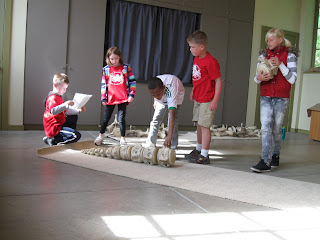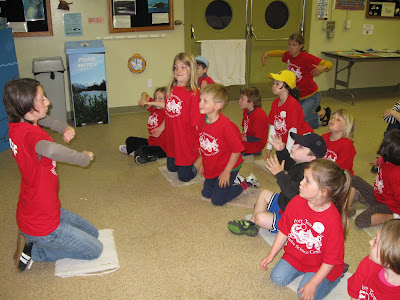Coastal Explorers day camp was the last camp of the season for us here at PTMSC. It was sad to end such a fun summer, but we truly went out with a great group of kids, so all is well that ends well. It is kinda hard to justify complaining about camp ending, anyway.
"AAARGH! Really! I just had a BLAST with multiple groups of engaged, knowledgeable, interesting, and exciting children. And I have to
stop?! What did I
do in my past life to deserve this!"
So, to recap Coastal Explorers camp for those of you who were not lucky enough to be there, I will give an overview of each days activities. A few pics are included to make you
extra jealous.
Monday:
We started off camp like most activities with 8-12 year olds start: running around.
 |
| Pictured above: running around |
Then we got down to business, and started creating our journals for the week. We also had a natural history game show, hosted by yours truly. Then a trip to the beach was in order, for a little scavenger hunt and group photo:
 |
| See if you can find me. I am the one in the red shirt. |
Tuesday:
We started Tuesday off with our favorite activity: running around. Not wanting to be outdone, I had to get into the action, and channel my inner 10 year old. Unfortunately, my inner 10 year old self played too many videogames.
 |
| Me tagging* the campers. |
*No "tagging" actually occured. Who invented tag anyway? Probably a fast 10 year old.
After the not-at-all-tiring tag session we went to the Marine Exhibit and fed some of the animals. I was pleasantly suprised at how respectful and gentle the campers were with the animals. If everybody cared about animals as much as some of these children do, this world would be a better place.
Then we had lunch. You might be asking youself "But Chris, why are you blogging about lunch? Lunch happens every day, camp or not." Ahhh, you would be correct. However,
after lunch we had my favorite activity.
Quiet Time.
 |
| Pictured above: not running around. |
So, after lunch we went into the forest and had a great afternoon learning about ecological niches, catching aquatic invertebrates, and visiting the chinese gardens. I particularly enjoyed the chinese gardens portion of our adventure, because it is an area with some interesting ecological and cultural history (which Jess so kindly explained very ellequantly to the group).
Wednesday:
I was really excited about Wednesday, because I was teaching a lesson on insects, and we were gonna get some nerdy, awesome, microscope time.
But first, we had a few options to start the day off with. We could either:
A) Sit quietly and reflect on our previous night's dreams
B) Have a calm, measured conversation on local politics
C) Listen to some light Jazz, with a spot of tea to warm us up on this chilly, foggy morning
D) RUN AROUND! A LOT! and laugh at slow counselors who try and catch us.
 |
| The Jazz was a close second. |
Luckily, afterwards we were able to get down to SCIENCE! Insect class went really well with almost all of the campers interested in the anatomy portion of the class.
 |
| Sorry to bug you guys, but sit up straight and bee attentive |
But the real stars of the class were the microscopes. The kids absolutely LOVED them!
Then we went up to the top of the bluff, played an epic game of camoflauge, and learned about some history of the bunkers. It was a tiring, yet rewarding experience.
Thursday:
I don't remember exactly how we started Thursday off, actually, maybe if I see a picture it will jog my memory. Wait was last sentence a run-on?
 |
The campers standing still are actually lying in wait
for some unwary counselor to try and catch them... |
Today we did what was probably the most popular activity among the kids: assembling "Spirit" the grey whale's skeleton. Aside from putting smiles on the campers' faces, this activity taught teamwork, deduction, and respect for the rules. The campers had to hold the bones very carefully, and keep an open dialogue going about the placement of each bone. They performed these tasks with ease.
And here is the "semi-finished" Spirit:
 |
| I have a bone to pick with those kids about that rib placement. |
Next we went out to the beach for some fun time, and we also made some beach art.
Friday:
The last day of camp arrived with all of the usual running around, but on this day we actually cut the running aound short (GASP!) so we could get out to Kinsey beach for some exciting tide pooling. We ended up having a very successful trip, with a large Gumboot chiton, and a massive Sea lemon as our prizes to bring back to the exhibit.
Then we ended the week with a bang,
literally. We made volcanoes on the beach. Each camper, or team of campers, tried to create the largest sand volcano. Then they chose their favorite lava color, and we erupted them one at a time (for optimum destruction, of course). One camper even stopped his volcano building for a seconed to inform Jess and I that he was, in fact, a sand-building champion. He went on to tell us that he was going to have to win this competition to help pay his mortgage!
I am really going to miss the camp season, and I had a great time. There are so many stories to tell, and even more memories to enjoy. If the campers had even 1/10th of the fun I did, then I bet it was the best thing they did all summer.
Summer Salutations,
Chris



















































